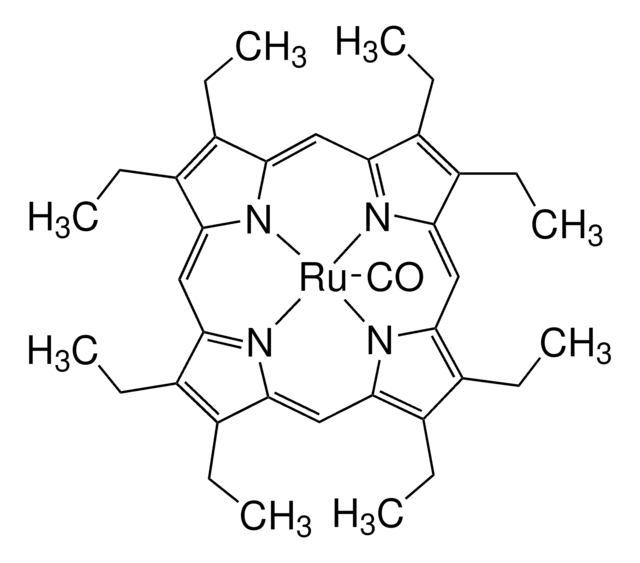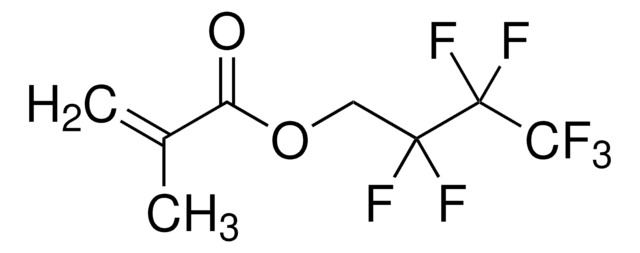If this product has an expiration or retest date, it will be shown on the Certificate of Analysis (COA, CofA). If there is no retest or expiration date listed on the product's COA, we do not have suitable stability data to determine a shelf life. For these products, the only date on the COA will be the release date; a retest, expiration, or use-by-date will not be displayed.
For all products, we recommend handling per defined conditions as printed in our product literature and website product descriptions. We recommend that products should be routinely inspected by customers to ensure they perform as expected.
For products without retest or expiration dates, our standard warranty of 1 year from the date of shipment is applicable.
For more information, please refer to the Product Dating Information document: https://www.sigmaaldrich.com/deepweb/assets/sigmaaldrich/marketing/global/documents/449/386/product-dating-information-mk.pdf
673625
Platinum octaethylporphyrin
95%
Synonym(s):
Platinum(II) 2,3,7,8,12,13,17,18-octaethyl-21H,23H-porphyrin, PtOEP
About This Item
Recommended Products
Assay
95%
form
solid
mp
>300 °C
λmax
381 nm
Orbital energy
HOMO 5.3 eV
LUMO 3.2 eV
OLED Device Performance
ITO/NPD/Alq3:PtOEP (4%)/Mg:Ag
- Color: red
- Max. Luminance: 100 Cd/m2
- Max. EQE: 2.5 %
ITO/NPD/CBP:PtOEP(6%)/Mg:Ag
- Color: red
- Max. Luminance: 100 Cd/m2
- Max. EQE: 0.8 %
SMILES string
CCc1c(CC)c2cc3c(CC)c(CC)c4cc5nc(cc6c(CC)c(CC)c(cc1n2)n6[Pt]n34)c(CC)c5CC
InChI
1S/C36H44N4.Pt/c1-9-21-22(10-2)30-18-32-25(13-5)26(14-6)34(39-32)20-36-28(16-8)27(15-7)35(40-36)19-33-24(12-4)23(11-3)31(38-33)17-29(21)37-30;/h17-20H,9-16H2,1-8H3;/q-2;+2/b29-17-,30-18-,31-17-,32-18-,33-19-,34-20-,35-19-,36-20-;
InChI key
WAODGUVBNLMTSF-XTPDIVBZSA-N
Looking for similar products? Visit Product Comparison Guide
Related Categories
Application
Storage Class Code
11 - Combustible Solids
WGK
WGK 3
Flash Point(F)
Not applicable
Flash Point(C)
Not applicable
Choose from one of the most recent versions:
Already Own This Product?
Find documentation for the products that you have recently purchased in the Document Library.
Customers Also Viewed
Articles
In this article, we demonstrate that bis-styrylbenzene derivatives show promising characteristics for very low lasing thresholds and discuss the design considerations for organic lasing molecules.
Since their discovery, organic light emitting devices (OLEDs) have evolved from a scientific curiosity into a technology with applications in flat panel displays and the potential to revolutionize the lighting market. During their relatively short history, the technology has rapidly advanced, and device efficiencies have increased more than 20-fold, approaching the theoretical limit for internal quantum efficiencies.
Professor Shinar highlights low-cost, disposable sensor configurations in organic and hybrid electronics for healthcare applications.
Professor Shinar highlights low-cost, disposable sensor configurations in organic and hybrid electronics for healthcare applications.
-
How can I determine the shelf life / expiration / retest date of this product?
1 answer-
Helpful?
-
-
How is shipping temperature determined? And how is it related to the product storage temperature?
1 answer-
Products may be shipped at a different temperature than the recommended long-term storage temperature. If the product quality is sensitive to short-term exposure to conditions other than the recommended long-term storage, it will be shipped on wet or dry-ice. If the product quality is NOT affected by short-term exposure to conditions other than the recommended long-term storage, it will be shipped at ambient temperature. As shipping routes are configured for minimum transit times, shipping at ambient temperature helps control shipping costs for our customers. For more information, please refer to the Storage and Transport Conditions document: https://www.sigmaaldrich.com/deepweb/assets/sigmaaldrich/marketing/global/documents/316/622/storage-transport-conditions-mk.pdf
Helpful?
-
Active Filters
Our team of scientists has experience in all areas of research including Life Science, Material Science, Chemical Synthesis, Chromatography, Analytical and many others.
Contact Technical Service











